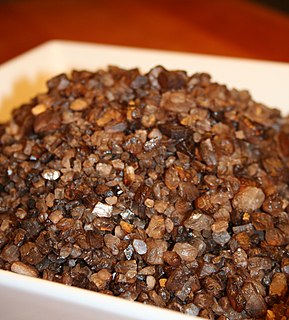
Ham is pork from a leg cut that has been preserved by wet or dry curing, with or without smoking. As a processed meat, the term "ham" includes both whole cuts of meat and ones that have been mechanically formed.

A kipper is a whole herring, a small, oily fish, that has been split in a butterfly fashion from tail to head along the dorsal ridge, gutted, salted or pickled, and cold-smoked over smouldering woodchips.

Barbecue or barbeque is a cooking method, a style of food, and a name for a meal or gathering at which this style of food is cooked and served.

Braunschweiger is the name for several types of sausages in different regions. In the German language, Braunschweiger is the demonym for people from Brunswick, but under German food law refers to a variety of mettwurst. In Austria, Braunschweiger is known as a type of parboiled sausage (Brühwurst), while American Braunschweiger is often confused with liverwurst.

Smoked salmon is a preparation of salmon, typically a fillet that has been cured and hot or cold smoked. Due to its moderately high price, smoked salmon is considered a delicacy. Although the term lox is sometimes applied to smoked salmon, they are different products.

Andouille is a smoked sausage made using pork, originating in France. It was brought to Louisiana by the French immigrants that would merge to create much of Creole culture.

A chipotle, or chilpotle, is a smoke-dried ripe jalapeño chili pepper used for seasoning. It is a chili used primarily in Mexican and Mexican-inspired cuisines, such as Mexican-American, Tex-Mex, and Southwestern dishes. It comes in different forms, such as chipotles en adobo. A chipotle's heat is similar to that of the Espelette pepper, jalapeño, Guajillo chili, Hungarian wax pepper, Anaheim pepper, and Tabasco sauce.

Lox is a fillet of brined salmon. Lox is one type of salmon product served on a bagel with cream cheese, and is usually garnished with tomato, sliced onion, cucumbers, and sometimes capers. The other type of salmon product is smoked salmon.

Smoked meat is a method of preparing red meat which originates in prehistory. Its purpose is to preserve these protein-rich foods, which would otherwise spoil quickly, for long periods. There are two mechanisms for this preservation: dehydration and the antibacterial properties of phenols and other chemicals in the absorbed smoke. In modern days, the enhanced flavor of smoked foods makes them a delicacy in many cultures.

Liquid smoke is a water-soluble yellow to red liquid used for flavoring. It is used as a substitute for cooking with wood smoke while retaining a similar flavor. It can be used to flavor any meat or vegetable. It is generally made by concentrating the smoke from wood, but can contain any number of food additives.

Smoked salt is an aromatic salt smoked with any number of select bark free woods for up to 14 days. The kind of wood used for smoking impacts the flavor, which can range from subtle to bold or even sweet. The most common choices are alder, apple wood, hickory, mesquite, and oak. Infused smoked salts like smoked bacon chipotle sea salt are very popular because of their dynamic flavor profiles.

Smoked fish is fish that has been cured by smoking. Foods have been smoked by humans throughout history. Originally this was done as a preservative. In more recent times fish is readily preserved by refrigeration and freezing and the smoking of fish is generally done for the unique taste and flavour imparted by the smoking process.

Cured fish refers to fish which has been cured by subjecting it to fermentation, pickling, smoking, or some combination of these before it is eaten. These food preservation processes can include adding salt, nitrates, nitrite or sugar, can involve smoking and flavoring the fish, and may include cooking it. The earliest form of curing fish was dehydration. Other methods, such as smoking fish or salt-curing also go back for thousands of years. The term "cure" is derived from the Latin curare, meaning to take care of. It was first recorded in reference to fish in 1743.

A smokehouse or smokery (British) is a building where meat or fish is cured with smoke. The finished product might be stored in the building, sometimes for a year or more. Even when smoke is not used, such a building—typically a subsidiary building—is sometimes referred to as a "smoke house." When smoke is not used, the term "meat house" is common.

Montreal-style smoked meat, Montreal smoked meat or simply smoked meat in Canada, is a type of kosher-style deli meat product made by salting and curing beef brisket with spices. The brisket is allowed to absorb the flavours over a week, and is then hot smoked to cook through, and finally steamed to completion.

Herrings are forage fish, mostly belonging to the family Clupeidae. They often move in large schools around fishing banks and near the coast. The most abundant and commercially important species belong to the genus Clupea, found particularly in shallow, temperate waters of the North Pacific and the North Atlantic oceans, including the Baltic Sea, as well as off the west coast of South America. Three species of Clupea are recognized. The main taxon, the Atlantic herring, accounts for over half the world's commercial capture of herrings.

Cooking oil is plant, animal, or synthetic fat used in frying, baking, and other types of cooking. It is also used in food preparation and flavouring not involving heat, such as salad dressings and bread dips, and in this sense might be more accurately termed edible oil.



















